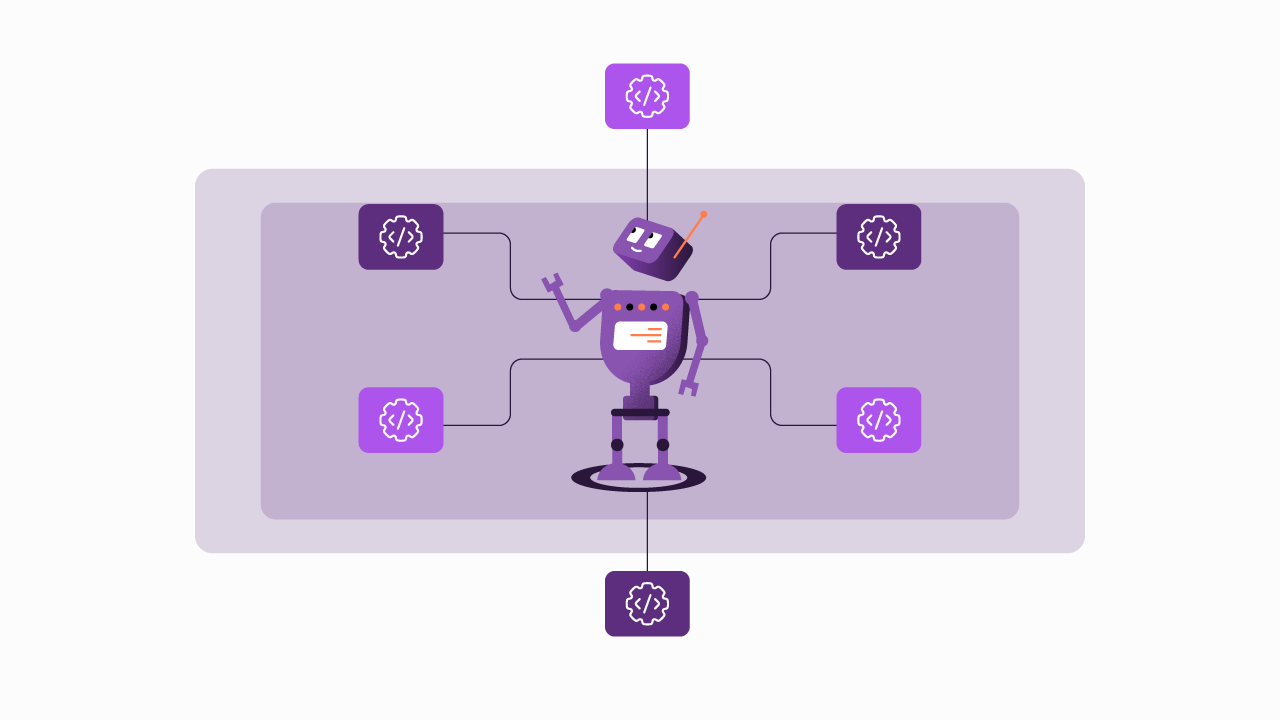The AI Integration Blueprint for Governing AI with MCP and Modern API Management
The Trillion Dollar Problem Every Enterprise Faces
Picture this: Your customer service AI confidently tells a premium client that their refund will take "3-5 business days", completely unaware that this customer has platinum status, recently complained about service issues, and is calling during a known system outage affecting their region. The AI had access to transaction data but missed the crucial context that would have transformed this interaction from frustrating to exceptional.
This scenario isn't hypothetical. Enterprises face a potential $2.6 to $4.4 trillion opportunity annually through intelligent, context‑aware AI systems, lost productivity at the lower bound of that range represents a realistic pain point (1). The culprit? Traditional integration platforms built for human users trying to serve AI agents, LLMs, and autonomous systems that operate at unprecedented scale and complexity. It's like trying to fuel a rocket ship at a gas station, the infrastructure simply wasn't designed for it.
Why Your AI Integration Plan Isn’t Delivering (Yet)
Most enterprises approach AI integration by retrofitting existing systems, treating AI applications like slightly more demanding web services, but that creates bottlenecks:
The Context Gap: AI systems receive fragmented data without the business logic, relationships, and contextual meaning needed for intelligent decision-making.
The Scale Problem: AI agents can generate magnitudes more API calls, overwhelming standard rate limiting and causing cascading failures across integrated systems.
The Intelligence Paradox: The “smarter” your AI becomes, the more context it needs to make good decisions, and traditional integrations (without MCP) do not understand context.
The Intelligent Backbone for AI Integration
We are building what we call the "Intelligent Backbone" a unified platform that combines integration platform as a service (iPaaS), AI-powered Federated API management & adaptive governance frameworks, supported by contextual intelligence specifically designed to integrate deterministic data points to non deterministic agents and AI systems.
This isn't just an upgrade to existing systems; it's a fundamental rethinking of how enterprise data flows, how APIs serve autonomous systems, and how context directs data traffic.
The Four Pillars That Make It Work
1. AI-Powered Integrations:
Sensedia Integrations create intelligent data highways that can interpret unstructured data, understand intent, and orchestrate workflows in real time by working with LLMs in real-time..
2. API Management with AI Capabilities:
Standard API management assumes predictable, human-driven usage patterns. Sensedia’s APIM provides context-aware gateways that understand AI request patterns, dynamic rate limiting that adapts to workload requirements, intelligent model versioning, and API monetization strategies designed for AI service providers.
3. Smart API Governance with AI Insights:
AI is the only thing capable of governing AI, delivering scalable oversight for autonomous systems. Adaptive Governance enables automated contract validation, built-in redundancies, and robust risk mitigation by providing full visibility into the impact of APIs across your ecosystem. This ensures compliance that dynamically adapts to evolving regulations.
4. Model Context Protocol (MCP):
This is where the magic happens. MCP transforms raw data into meaningful context that AI systems can truly understand and act upon.
Why Major AI Companies Are Betting Big on MCP
The breakthrough that's revolutionizing AI integration isn't a proprietary technology locked behind corporate walls, it's an open-source protocol developed by Anthropic that major players including Microsoft, OpenAI, and Google have rapidly adopted. This movement represents a fundamental shift in how AI systems will interact with enterprise data.
What Makes MCP Revolutionary?
MCP solves the context problem by standardizing how AI systems interact with enterprise data sources. Instead of working blindly with isolated data points, the protocol gives LLMs structured access to the relationships, dependencies, and business logic across your API ecosystem. This enables AI to make informed decisions based on a contextual understanding of your data, rather than reacting to fragmented or incomplete signals.
- Customer Journey Context: Full relationship history, preferences, and interaction patterns
- Business Logic Relationships: How different data elements connect and influence each other
- Operational Constraints: Current system status, policy limitations, and process requirements
- Strategic Objectives: How individual decisions align with broader organizational goals
The transformative impact of MCP is already being felt across enterprise AI systems. By supplying grounded context, we significantly reduce AI hallucinations and enhance model accuracy, especially in tasks that rely heavily on nuanced, context-rich data.
Deployment cycles become faster, while security and governance benefit from actions that are governed directly at the protocol level.
Building Your MCP Implementation Strategy
Successfully implementing MCP requires strategic thinking beyond technical configuration:
Phase 1: Context Mapping
Identify your organization's critical business contexts, what is the information that transforms data from noise into insight? Focus on customer interactions, operational processes, and decision-making workflows where context makes the biggest difference.
Phase 2: MCP Server Deployment
Implement MCP servers for your most critical data sources, starting with systems that drive key business decisions. Prioritize customer databases, operational systems, and real-time data feeds that power AI applications.
Phase 3: AI Agent Configuration
Train your AI agents to consume and leverage MCP-enabled contexts effectively. This involves fine-tuning how agents interpret contextual information and make decisions based on comprehensive business understanding.
Phase 4: Optimization and Scaling
Continuously monitor context delivery performance, expand MCP implementation to additional systems, and refine how context flows through your organization.
Security, Performance, and Governance Best Practices
Securing AI systems requires moving beyond traditional models designed for human users. A Zero-Trust Architecture ensures every AI interaction is continuously verified, while non-human authentication methods (like cryptographic certificates and behavior-based controls) protect access. Real-time monitoring and AI-specific audits are essential to catch threats like prompt injection, model extraction, and adversarial inputs.
Performance optimization must also be AI-aware. Predictive capacity planning anticipates workload spikes, context caching reduces decision latency, and AI-specific load balancing ensures efficient processing across models.
Finally, effective governance should be invisible yet powerful. Automated compliance monitoring, built-in bias detection, and audit trail automation ensure security, fairness, and accountability. Driving experimentation without sacrificing control.
The Rise of API-First AI
We’re entering an era of autonomous integration systems that can discover, connect, and optimize their own workflows, dramatically reducing the need for manual configuration or intervention. These systems are being designed to adapt in real time, continuously learning from patterns, performance metrics, and business outcomes to make smarter integration decisions and be less and less dependent on human interactions.
Organizations are now designing APIs specifically for machine consumption rather than retrofitting human-centric interfaces. This shift acknowledges that AI systems process and interpret information differently than humans. Rather than relying on documentation or trial-and-error, machine-consumable APIs provide structured, context-rich data that AI agents can understand and act on instantly. This includes:
Semantic API Design that includes contextual metadata enabling AI systems to understand not just what data is available, but how it should be used.
Context-Aware Data Governance that adapts access controls based on the requesting AI system's purpose, clearance level, and current operational context.
Machine-Readable Business Logic that embeds policy rules and business constraints directly into API responses, enabling AI systems to make compliant decisions autonomously.
Recap: Your Strategic Roadmap to AI Integration Success
Assessment Phase: Know Where You Stand
Begin by evaluating your current integration maturity across four dimensions:
- Data Accessibility: How easily can AI systems access the data they need?
- Context Richness: Do your integrations preserve business context or strip it away?
- Scalability: Can your current infrastructure handle AI-scale API consumption?
- AI Readiness: Are your compliance and security frameworks prepared for AI systems?
Implementation Phase: Build Your Intelligent Backbone
Start with high-impact use cases that demonstrate clear business value:
- Customer Experience: Implement MCP-enabled AI agents that understand full customer context for personalized service interactions.
- Automation: Deploy AI systems that can automate routine business processes while respecting business rules and constraints.
- Predictive Analytics: Create AI systems that understand not just historical data, but the business context that makes predictions actionable.
Optimization Phase: Scale and Evolve
Continuously experiment and expand on your AI capabilities to avoid falling behind:
- Expand MCP Implementation to additional business domains and data sources.
- Develop APIs designed for AI consumption and contextual understanding
- Implement Smart API Governance that adapts policies based on outcomes
The AI Imperative: Win Early or Fall Behind
While most organizations are still debating AI strategy, the winners are already building AI-native infrastructure that will separate them from the pack:
Speed is Crucial: Deploy new AI capabilities in months, not quarters. While competitors struggle with integration bottlenecks, stay three steps ahead.
Intelligence Multiplies: Context-aware AI doesn't just automate, it amplifies human decision-making with recommendations that understand business, not just data.
Risk Becomes Manageable: Smart API governance isn't just about setting guardrails, it's about building confidence to move faster on new opportunities that paralyze competitors.
Revenue Streams Emerge: AI-native integrations unlock entirely new ways to monetize your digital assets. Don’t wait for a competitor to get there first.
The brutal reality? AI integration isn't a nice-to-have technology upgrade. It's the new baseline. Time is ticking, and your competitors aren’t waiting for you to catch up.
Ready to Define Your AI Integration Strategy?
The Intelligent Backbone is a strategic blueprint for competing in an AI-driven marketplace. Organizations that adopt AI-ready iPaaS, intelligent API management, and Model Context Protocol today will shape the competitive landscape of tomorrow.
The future belongs to organizations that build the smartest AI integration architectures. Start your transformation today by laying the strategic foundation that aligns with and accelerates your AI ambitions, because the question isn’t whether you'll need these capabilities…
…it's whether you'll build them before your competition does.
Begin your API journey with Sensedia
Hop on our kombi bus and let us guide you on an exciting journey to unleash the full power of APIs and modern integrations.
Related content
Check out the content produced by our team.
Embrace an architecture that is agile, scalable, and integrated
Accelerate the delivery of your digital initiatives through less complex and more efficient APIs, microservices, and Integrations that drive your business forward.





.svg)




.png)

